Abstract
The use of mineral-based cutting fluids in machining has the drawback of affecting the environment and industries are under pressures to reduce its use in favor of cleaner productions. In this regard, the vegetal-based cutting fluids can be a superior alternative, provided they improve the technical outcomes. In the milling process, dry cutting is commonly performed, however, the application of cutting fluids using the minimum quantity of lubricant (MQL) method has proven advantageous when compared with dry machining. Furthermore, in the midst of the availability of several cutting fluids in the market, the testing of their individual performance can ascertain their potential and effectiveness for a particular application. This study examined the performances of two vegetable-based and one mineral-based oils applied by the MQL method, followed by their comparison with dry cutting amid end milling of AISI 1045 steel with TiAlN-coated cemented carbide inserts. The cutting temperature, machining forces, power consumption, workpiece surface roughness, tool life, and tool wear mechanisms were chosen as the output parameters. The experiments were conducted using two cutting speeds (150 and 200 m/min) and feed rates (0.07 and 0.14 mm/tooth), and constant axial (1 mm) and radial depths of the cut (25 mm). The temperature was measured using a K-type thermocouple soldered to the part and an infrared camera. The power was monitored with a Fluke 435 energy analyzer, and the machining force components with a Kistler dynamometer. The worn inserts were inspected under a scanning electron microscope (SEM) to analyze the tool wear mechanism. The MQL-assisted application of the cutting fluids notably lowered the cutting temperature and increased the tools’ lives. However, the cutting fluids did not reflect any significant effect on the machining force, power consumption, or surface roughness. Among all the analyzed cutting conditions, the abrasive wear mechanism dominated, damaging the cutting edges, flank, and rake surfaces of the cutting tools. In addition, adhesive and diffusion wear mechanisms were also observed.
1. Introduction
In the metal–mechanical industry, the milling process is characterized by great versatility to produce parts with complex geometries accompanying high material removal rates. In this process, the cutting tool is subjected to thermal and mechanical variations, causing the appearance of edge damage and wear, reducing its useful life, and compromising the component’s dimensional accuracy and surface integrity [1].
Milling is typically conducted either by dry cutting or with cutting fluids [2]. Dry machining eliminates lubrication-cooling, minimizing health risks from illness associated with prolonged exposure to metalworking fluids [3,4]. It dramatically reduces environmental pollution and provides substantial cost savings in cutting fluid management, treatment, and disposal [5]. However, the main problems in dry machining include shorter tool life, loss of the tool’s geometrical shape and accuracy, and poor surface integrity with increased residual stresses on the machined component due to high temperatures at the cutting interfaces [6,7]. On the other hand, cutting fluids amid milling can be applied using high pressure, flooding, and MQL methods [8].
The alternative MQL technology (minimum quantity of fluid—MQL, spray, and mist) has been massively experimented. It is considered as the most convenient solution to minimize the problems of dry machining, high cost of cutting fluids, and ecological and legitimate challenges to the safety of the environment and peoples’ health involved during the execution of the process [9,10]. In the MQL approach, a mist of the fluid, in an appropriate amount, can promote the lubri-cooling action at the chip–tool–workpiece interface [11] and reduce friction and work material adhesion on the tool [12,13,14] when applied to the cutting area. However, the MQL method’s efficiency depends on the type of fluid used [15], the machining process, distance (from the machining zone), and the geometry of the application nozzle since these factors are responsible for wetting the cutting region adequately [16].
According to a study [17], the mist generation relies on the pressure and flow of the compressed air needed to carry and guide the cutting fluid. It directly interferes with the efficiency of the lubri-cooling process to change the surface roughness and tool life.
However, the use of the MQL strategy seems more prevalent in research laboratories than in shop floors of metal–mechanical industries [8]. This comment is based on conclusions made by some of the authors of this article after reviewing recent literature, visiting several metal industries, and conducting conversations with some machinists. The actual reasons for the failure to implement the MQL strategy might lie in the lack of proper understanding of the process. Therefore, extensive research is needed to improve the users’ confidence in the system. A general search of research articles with the acronym “MQL” (either in the title, abstract, or keywords) in the Scopus database in February 2023 resulted in over 2760 documents. This number reveals the importance of the system, encouraging the execution and extension of the present research work. In this regard, the present research investigates the cutting temperature, machining force, power consumption, surface roughness, tool life, and wear mechanisms during end milling of AISI 1045 steel using the TiAlN-coated cemented carbide inserts with the MQL-assisted application of vegetable- and mineral-based oils. Dry cutting was also performed to compare the effects of MQL-assisted cutting with dry cutting. The article is organized into specific sections and subsections, which are: Introduction; Experimental Procedure with subsections of Materials Characterization, Experimental Conditions, Temperature Measurement, Measurement of Power Consumption, Cutting Forces, Surface Roughness, and Tool Wear Measurements; and Results and Discussions with subsections of Cutting Temperature Measured by the Welded Thermocouples, Cutting Temperature Measured by the Infrared Camera, Comparison of the Two Temperature Measurement Methods, Machining Force, Machining Power, Surface Roughness, Tool Life and Wear Mechanisms. Finally, the Conclusions section summarizes the studies.
2. Experimental Procedure
This section provides the details of the experimental procedures conducted amid the investigation. Figure 1 presents the development stages of the experimental work via a flow chart.

Figure 1.
Diagram and steps of the research.
2.1. Materials Characterization
The AISI 1045 steel work specimen used in the experiments was in the form of rolled bars with initial dimensions of 100 mm × 100 mm × 500 mm. The chemical composition of the same is displayed in Table 1. Following the standard test methods [18], the material was characterized by its stress–strain behavior, resulting in an average ultimate tensile strength of 869 MPa and elongation of 13.60%. Following the ASTM E92-17 (2009) standard, its hardness resulted in an average hardness of 262 ± 11.35 HV1. Figure 2 shows the specimen’s conventional microstructure, composed predominantly of coarse pearlite and ferrite grains [19].

Table 1.
Chemical composition of AISI 1045 [20].
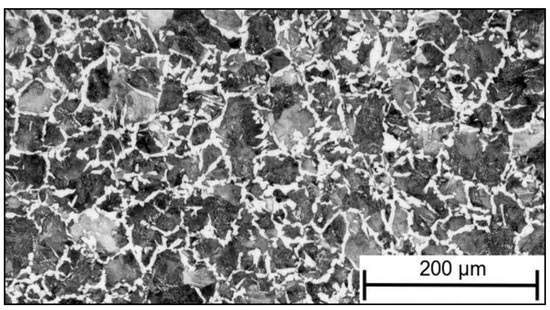
Figure 2.
Microstructure of the specimen material AISI 1045 steel [19].
Three different integral cutting oils were evaluated in this study. Two were manufactured by Special Mix Industrial Ltda, Curitiba, Brazil (MQL14 and MQL15), and the third by ITW Chemical Products Ltd. (LB 1000). MQL14 is mineral-based, and MQL15 and LB 1000 are vegetable-based oils. The main characteristics of these oils are summarized in Table 2. This information was found in the material safety data sheet (MSDS) prepared according to [21]. The three oils were individually applied by MQL using the spray unit manufactured by Bielomatik, Römerstein, Baden-Württemberg, Germany, model B1-210. They were applied with a flow rate of 45 mL/h (individually calibrated for each oil) and an air pressure of 6 bar.

Table 2.
Characteristics of the cutting oils [22].
2.2. Experimental Conditions
A CNC machining center manufactured by Cincinnati Milacron, Cincinnati, OH, USA (model Arrow 500) with 5.5 kW power and a maximum rotation speed of 6000 rpm (Figure 3a) was used in the machining tests. TiAlN-coated cemented carbide inserts (manufactured by Mitsubishi Materials, Aurangabad, Maharashtra, India) with specifications AOMT123608PEER-M VP15TF (Figure 3b) were employed as the cutting tool. These inserts have a cutting-edge length of 12 mm, a corner radius of 0.8 mm, and a rake angle of 11°. These cutting tools feature M-type chip breaker geometry and are recommended for machining general carbon steels (P grade) with the recommended cutting speed (vc) ranging from 110 to 200 m/min, an axial depth of cut (ap) up to 4 mm, and a feed per tooth (fz) of 0.15 mm/tooth, when using a radial depth of cut (ae) that is greater than 75% of the diameter of the tool holder shank. The inserts were attached to a 25 mm diameter tool holder with a 90° approach angle and ISO 13399 designation or Mitsubishi Materials description APX3000R253SA25SA (Figure 3b).
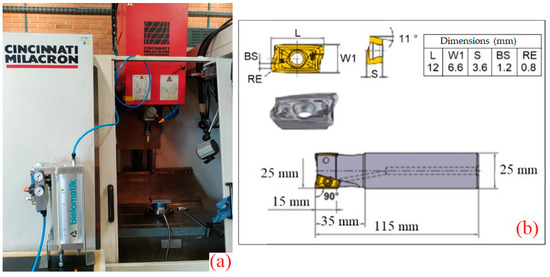
Figure 3.
(a) CNC machine center; (b) APX3000R253SA25SA tool holder and AOMT123608PEER-M inserts used in the end milling tests.
The machining experiments were divided into two test sets: one for studying the temperature, force, power, and surface roughness and the other for studying tool life. A factorial design was used in the first set of tests and the levels of the input variables (cutting speed and feed rate) are presented in Table 3. The radial and axial depths of the cut were kept constant. The values of these cutting parameters were recommended by the tool manufacturer for machining medium carbon steel. In another set of tests targeting the tool life, only the cutting speed was varied at two levels. One of these levels was kept higher than those values that were previously recommended by the cutting tool manufacturers in an attempt to further explore the action of the cutting fluids.

Table 3.
Set of cutting conditions for the experimental tests to investigate the temperature, power consumption, machining forces, and surface roughness.
The experiments were carried out under dry conditions and with the external application of cutting oils using the MQL approach. The oils were sprayed at a flow rate of 45 mL/h by two injector nozzles placed at a 180° angle, distanced from each other around the tool holder bar with an inclination of ± 45° (in relation to the workpiece), and were approximately 20 mm away from the cutting tool. Although the tool holder can have three inserts, the tests were performed with only one insert fixed to save time, work material, and cutting tools without compromising the comparative results [23]. To avoid the influence of tool wear, for the first set of tests, a new insert was used each time the maximum flank wear (VBBMax) reached 0.1 mm. All the tests were triplicated for the statistical reliability of the results. An analysis of variance (ANOVA) and a test comparing the pairs by Tukey honestly significant difference (HSD) were carried out with a reliability index of 95% and significance level of 5%.
To improve the reliability of the output variable measurements, all the necessary measures recommended by the equipment manufacturers were thoroughly followed and employed. All the equipment were previously calibrated following the instructions of the manufacturers.
2.3. Temperature Measurement
In this work, the temperature was measured using thermocouples soldered to the lateral face of the workpiece bar and infrared images [24] simultaneously (during the same trials). Thermocouples are widely used to study the temperature in milling processes; however, the resilience and accuracy of temperature gradients limit the measurements [25], justifying the comparison with infrared images.
The work material bar was previously peeled for the tests to remove the oxide layer from the top and lateral surfaces using an eight-tooth face milling cutter. A 100 mm long cut was made in the transversal direction of the bar. This cutting length was divided into four sections of 25 mm each, and the cutting conditions were changed (as shown in Table 3 and Figure 4a–c). The yellow arrow in Figure 4b indicates the cutting direction. The thermocouples were welded on the lateral surface of the AISI 1045 steel bar, placed 1.0 mm from the top border and 10 mm from the end of each section. The signals of the thermocouples were managed by the Agilent® acquisition board, model 34901A, and Agilent Bench Link Data Logger 3 version 4.3.00 software.
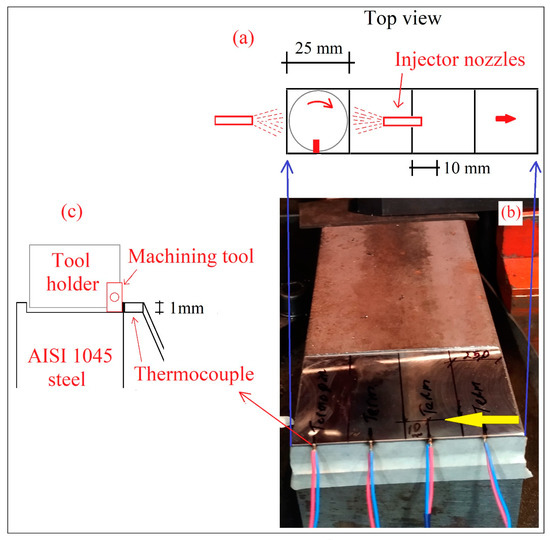
Figure 4.
Illustration of the welded K-type thermocouples on the workpiece: (a) top view; (b) details of the welded thermocouples; (c) side view.
In the temperature measurement system, a FLIR thermal camera model SC 620, positioned 90 cm away from the lateral surface of the specimen and aligned with the machine spindle axis (as shown in Figure 5), was used to capture the thermal images. The camera was adjusted from the targeted object at a room temperature of 22.5 °C, emissivity (ε) of 0.79 (steel emissivity), and acquisition rate of 2 frames/second. The highest temperature inside the circle of Figure 5b was captured in each frame and the average was calculated. As shown in this figure, the Thermal Studio software (demo version 1.7) was used to produce these thermal images.

Figure 5.
(a) Illustration of the temperature measurement method by a thermal camera and (b) the image generated in the milling test experiments.
2.4. Measurement of Power Consumption, Cutting Forces, and Surface Roughness
The milling power measurements were performed with a Fluke power analyzer (model 435) installed in the machining center’s power supply panel. Power Log 430-II software (demo version 5.9) was used to obtain the active power data.
The components of the machining forces were measured by a calibrated platform dynamometer (model 9272) and signal amplifier (model 5223) with the software DynoWare, complete version 2825A-03-2. Kistler Instrument AG (Eulachstrasse, Winterthur, Switzerland) manufactured all these instruments. The acquisition rate was settled at 1000 Hz and the measurements were performed throughout the entire machining process. The signals measured during the machining of the full diameter in each section were considered for calculating the average values.
After machining, the workpiece’s surface roughness parameters (Ra, Ry, and Rz) were measured with an accurately calibrated portable roughness meter from Time Group Inc., model TR220, manufactured by Digiwork Instruments, Concord, ON, Canada, with a resolution of 0.01 µm. Initially, the first measurements were performed with a cut-off (λ) of 0.8 mm. This cut-off could be adjusted whenever necessary according to the NBR ISO 4288 (2008) standard. The parameters were measured three times in distinct positions (Figure 6) for each test. Since the machining tests were replicated three times, nine measurements were used to calculate the average values.
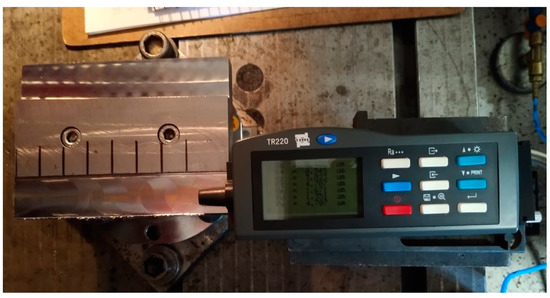
Figure 6.
Illustration of the surface roughness measurement.
2.5. Tool Wear Measurements
The tool wear was periodically monitored at intervals that made it possible to generate the wear vs. time curves. Whenever the process was interrupted, the tool holder with the insert was removed from the machine and taken to a Zeiss stereomicroscope (model Discovery V12) to measure the flank wear. The flank wear was monitored at the leading cutting edge, corner radius, and wiper edge (all can be identified in Figure 7).
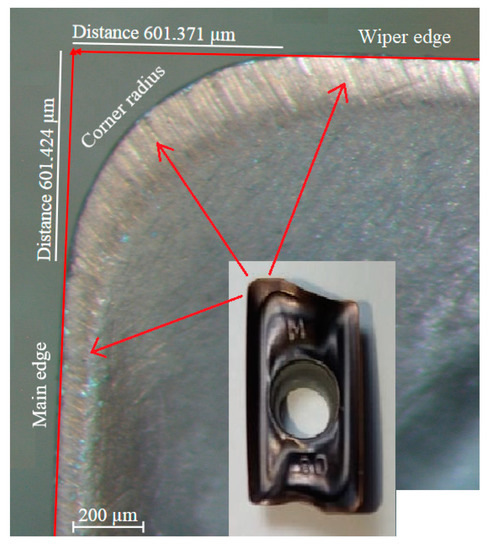
Figure 7.
Images identifying the tool edges where the wear was monitored in the tool life tests.
The end-of-tool-life criterion was determined after pre-tests that indicated the predominance of corner wear in the flank face. The tests were interrupted when the flank corner wear VBC reached 0.3 mm. The wear mechanisms of the worn-out tools were analyzed within the Vega3–TESCAN scanning electron microscopy (SEM) (manufactured by TESCAN ORSAY HOLDING, Brno-Kohoutovice, Brno, Czech Republic) equipped with an Oxford INCAx-act dispersive energy spectroscopy (EDS) unit and VegaTC and AZtec-P2 software, Version 2.72.
3. Results and Discussions
3.1. Cutting Temperature Measured by the Welded Thermocouples
The average results of the temperature were measured by the K-type thermocouple welded on the workpiece surface, considering all the tests and replicas carried out (in the four cutting conditions given in Table 3) for the dry cut (as illustrated in Figure 8a) and for all the wet cutting atmospheres (shown in Figure 8b). The surface response plot in Figure 8a highlights the influence of the cutting speed and feed per tooth on the cutting temperature. In this case, the lowest machining temperatures were obtained with the lowest cutting speed and feed per tooth values, as predicted in the literature [26]. In Figure 8b, the higher milling temperatures in dry cutting compared to cutting with MQL were 38.83%, 40.00%, and 54.23% lower for the LB1000, MQL15, and MQL14 oils, respectively. ANOVA confirmed the significant difference in the temperatures observed in dry cutting compared to MQL. Table 4 presents the results of the Tukey HSD tests for the temperatures measured by the K-type thermocouples. A similarity of the cutting temperatures with the vegetable-based fluids LB1000 and MQL15 was evident. In addition, it was noticed that the lowest temperature was induced by the mineral-based oil MQL14.
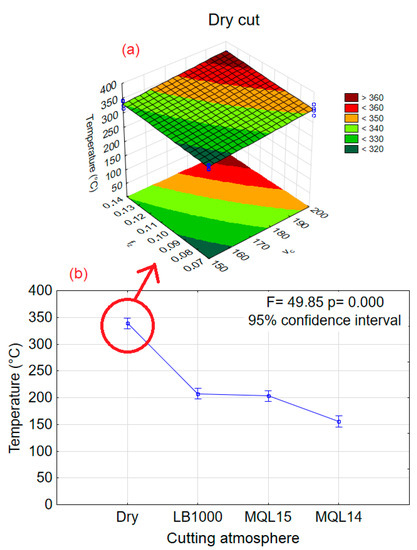
Figure 8.
Temperature measured with the thermocouple for the dry cut. (a) The surface response plot shows the cutting conditions’ influence and (b) the effect of the machining atmosphere.

Table 4.
Comparison between pairs (Tukey HSD) to identify the lubri-coolant conditions that presented different temperature values measured by the thermocouple.
The effect of the cutting parameters on the machining temperature for the three oils assessed is illustrated by the Pareto charts presented in Figure 9. Within the reliability index of 95%, the cutting speed was a significant parameter, regardless of the oil and the feed rate for the LB100 and MQL14 oils. When using the MQL15 oil, the feed rate did not show a major influence. The cutting speed presented a more substantial influence than the feed rate for LB100 and MQL15 oils. These results present the reverse trend for the MQL14 oil.
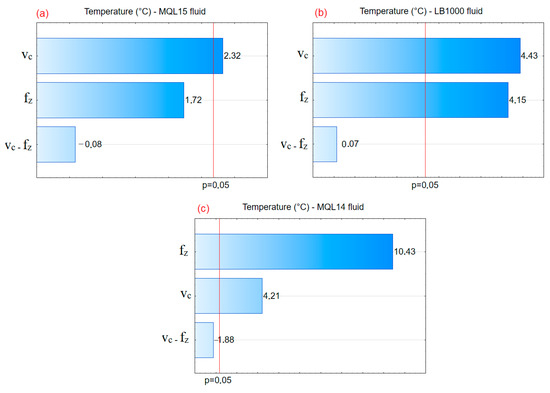
Figure 9.
Pareto chart illustrating the influence of the cutting conditions with the MQL oils (a) MQL15, (b) LB1000, and (c) MQL14.
3.1.1. Cutting Temperature Measured by the Infrared Camera
The temperature results of the experiments carried out with the infrared camera described the behavior of the average maximum temperature of the frames as a function of the different cutting parameters and lubri-coolant conditions. Figure 10a shows the surface response plot for the dry cut and Figure 10b shows the Pareto chart for this cutting atmosphere, depicting the influence of the cutting parameters. Figure 10c compares the cutting atmospheres’ results under the conditions tested (Table 3). The results presented in Figure 10c indicate that the oils applied by MQL significantly reduced the temperatures compared to dry cutting by 34.86%, 35.92%, and 38.50% for the LB1000, MQL14, and MQL15 fluids, respectively. ANOVA statistically confirmed this decrease in the milling temperature with a reliability index of 95%. Figure 10a shows the influence of the cutting speed and feed per tooth on the cutting temperature during the dry milling. The results follow the trends encountered in the literature [26]. In this case, the lack of an oil application in the process suggests that the most suitable cutting condition for milling AISI 1045 steel are the lowest values of the cutting speed and feed rate.
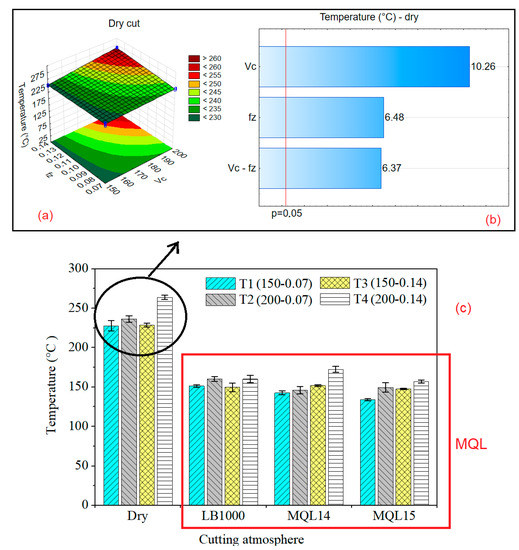
Figure 10.
Cutting temperature measured by the infrared camera. (a) Surface response plot showing the influence of the cutting conditions for dry cut; (b) Pareto chart for dry cut; (c) comparisons of the machining atmospheres.
The surface response plots and Pareto charts showing the influence of the cutting parameters on the cutting temperature for the tests with MQL oils are illustrated in Figure 11 (for the vegetable-based oils LB1000 and MQL15) and Figure 12 (for the mineral-based oil MQL14). The Pareto diagrams illustrated in Figure 11d and Figure 12b indicate that the cutting speed and feed per tooth are the variables with the most significant influence on the machining temperature monitored by an infrared camera during the MQL application of the MQL15 and MQL14 oils. These results were expected since the change in the cutting speed also changes the deformation rate of the material in the shear planes, and changing the feed rate also changes the amount of material that is deformed in the shear planes. Consequently, the shear energy is modified, leading to heat generation, as reported in the literature [27]. However, in the MQL application of the LB1000 fluid, the values of 0.07 and 0.14 mm/tooth did not significantly contribute to changes in the cutting temperature, although it was lower than the dry cutting. The cutting temperature measured with the thermal camera is an external temperature on the bodies involved (insert, toolholder, workpiece, and chip), with the maximum temperature noticed at the chip and insert surfaces. These temperatures are the results of the heat generated and dissipated in the process and, therefore, are the results of the lubricating and cooling actions of the oils applied. In the present investigation, these actions were not studied separately, however, the results with the LB1000 oil suggest that the balance of lubrication and cooling actions are equivalent to the range of feed per tooth studied.
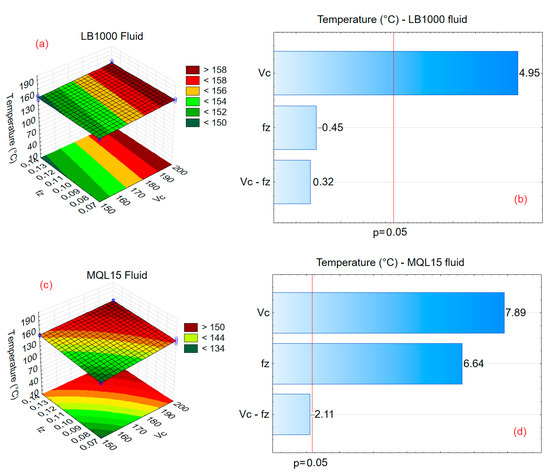
Figure 11.
Surface response plots and Pareto charts of the temperature measured by the infrared camera when machining with the vegetable-based oils. (a,b) LB1000; (c,d) MQL15.
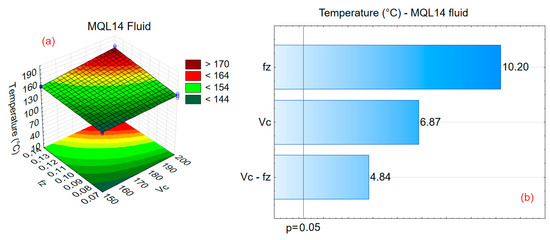
Figure 12.
Temperature measured by the infrared camera when machining with the mineral-based oil MQL14. (a) Surface response plot; (b) Pareto chart.
3.1.2. Comparison of the Two Temperature Measurement Methods
The temperature results of the experiments using the K-type thermocouple welded on the workpiece surface and infrared sensor were mostly coherent. They described the temperature behavior as a function of the different cutting parameters and lubri-coolant atmospheres.
As shown in Figure 13, the lubri-cooling condition or cutting atmosphere showed coherent results of temperatures for both measurement methods used, except for the MQL14 mineral-based oil. With the thermocouples, the temperature on the surface of the workpiece with the MQL14 oil was lower when the other two oils were applied. With the thermal camera, the average maximum temperature in the frames was similar for the three oils applied by MQL. Another significant result lies in the highest temperatures measured by the thermocouples. They were welded on the lateral surface of the workpiece (remarkably close to the cutting zone), and thus were close to the heat flow zone. The thermal camera is an excellent non-intrusive system, but it is subjected to the interference of fluid mist, equipment position, chip exit, and depth of cut because these factors may change the emissivity and influence the infrared light reflected and absorbed by the equipment, masking the temperature values. However, the system is suitable for comparative analysis, as proved by Figure 13. Dry cuts present the highest temperatures measured by both systems, and both showed equivalent temperatures obtained with MQL of vegetable-based cutting fluids LB100 and MQL15.
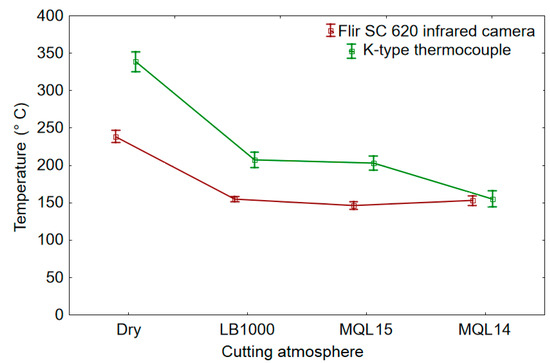
Figure 13.
Comparison of measurement methods.
3.2. Machining Force
Figure 14a compares the machining forces for all the lubri-cooling conditions evaluated. It can be observed that the lowest average machining forces were induced by dry milling and with the MQL14 mineral-based oil. The lower machining force presented by the MQL14 oil can be explained by the higher load capacity and wettability of this mineral-based oil compared to the vegetable-based oils LB1000 and MQL15. The same finding was demonstrated by [19]. This suggests more excellent uniformity of the oil film on the cutting tool’s surfaces to reduce the friction at the chip–tool–workpiece interfaces, leading to lower machining forces. Thus, the dry cuts were expected to exhibit lower forces than wet cuts as a result of the cooling action of the cutting fluids. Similar results were also found by Carvalho et al. (2019) [28] in the turning of AISI 1050 steel with cemented carbide tools under dry and flood applications of vegetable- and mineral-based cutting fluids. The cooling effect of these fluids reduces the temperatures at the chip in the shear planes, maintaining the work material and the chip at higher levels of strength and thus demanding more energy for deformation required for machining.
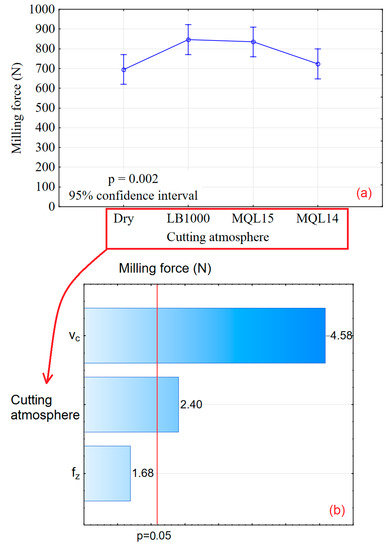
Figure 14.
Machining force results. (a) Influence of the cutting atmosphere; (b) Pareto chart with the most relevant variables for the machining force.
The Pareto chart of Figure 14b indicates the cutting speed as the most significant parameter affecting the machining force. In this case, as illustrated in Figure 15 and Figure 15b, the machining force tends to decrease as the cutting speed increases, regardless of the lubricious-coolant condition. This is possibly due to the decrease in chip shear strength with the increase in temperature generated at the chip and tool interface, as outlined by Bashir et al. [29]. The cutting atmosphere was statistically crucial with a 95% of reliability index. Although the feed rate is usually crucial for the cutting force (because it determines the chip thickness), in the present investigation, the feed per tooth did not significantly influence the milling force, possibly because the range used was not high enough. Furthermore, as shown in Figure 15c, the machining force increases when the feed per tooth is changed from 0.07 to 0.14 mm/tooth.
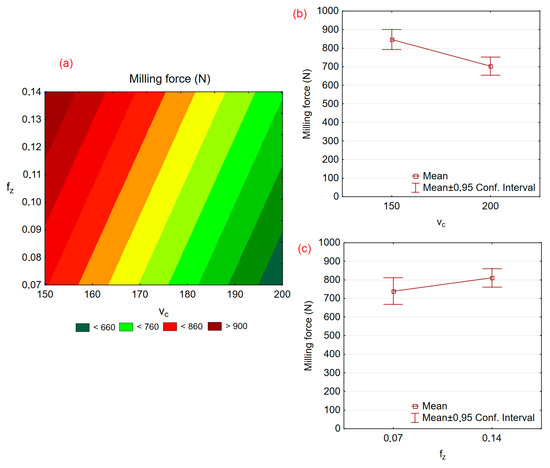
Figure 15.
Machining force results. (a) Surface response plot showing the influence of the cutting speed and feed per tooth; (b) the contribution of the cutting speed; and (c) the contribution of the feed per tooth.
3.3. Machining Power
Figure 16 shows the average machining power obtained in the milling of AISI 1045 steel when applying the various lubri-coolant conditions during the cutting process (shown in Table 3). In Figure 16a, the tendency of the power consumption is shown graphically when changing the cutting atmosphere. It is seen that the cutting atmosphere did not show any considerable influence on the results. The Pareto chart of Figure 16b and the ANOVA results of Table 5 confirm this with a 95% of reliability index and 5% of the significance level. Only the cutting speed and the feed rate influenced the electrical power consumption of the machine. The more significant contribution of the cutting speed and feed per tooth to the milling power was expected since most of the energy required to shear the material comes from the main axis of the machine. These power consumption results are closely related to the machining force results since the power is the product of the force times the velocity or the energy divided by the time unit. The electrical energy measured comprises the cutting power and the feed power simultaneously. Comparisons of the tendency graphics of the forces (Figure 14a) and power (Figure 16a) corroborate this finding.
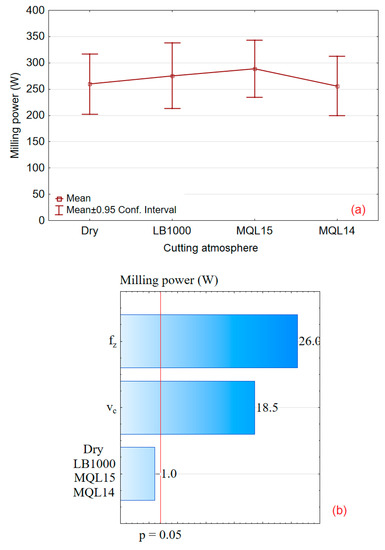
Figure 16.
Power consumption results. (a) Effect of lubri-cooling conditions on machining power and (b) Pareto chart showing the effects of the analyzed variables.

Table 5.
ANOVA of the machining power.
3.4. Surface Roughness
Figure 17 illustrates the results of the surface roughness parameters Ra, Ry, and Rz when milling the AISI 1045 steel under various cutting atmospheres. It was observed that the mineral-based oil MQL14 induced the best surface roughness while considering the three parameters (Ra, Ry, and Rz) among all the lubri-cooling conditions evaluated. This result was most likely obtained due to the greater load capacity, wettability, and lower viscosity of the MQL14 mineral-based fluid compared to the LB1000 and MQL15 vegetable-based fluids, as highlighted in the work of [19]. According to the ANOVA results with a 95% reliability index, the Ry parameter did not present significant statistical variations when changing the cutting atmosphere. In this case, the p-value noted was 0.2882.
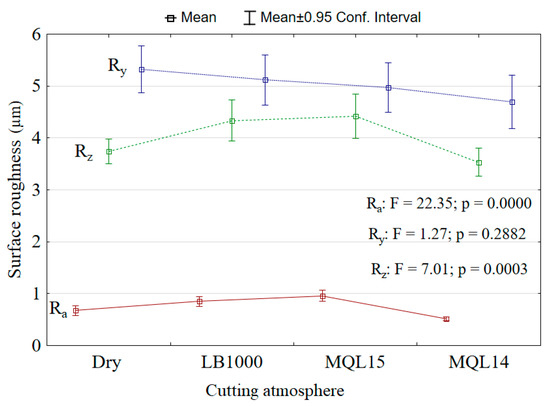
Figure 17.
Influence of lubri-cooling conditions on the surface roughness Ra, Ry, and Rz.
Table 6 illustrates the Tukey HSD test results of comparing the pairs of milling atmospheres investigated (MQL and dry) that altered the surface roughness parameters Ra and Rz. This analysis observed that Ra and Rz presented similar values with the MQL application of vegetable-based fluids LB1000 and MQL15. In continuation, the values of Rz (during dry milling conditions) also present similar findings when MQL14 mineral-based oil was used.

Table 6.
Tukey HSD test to identify the lubri-cooling conditions that presented statistically different Ra and Rz roughness parameters.
The effects of the cutting parameters and cutting atmospheres on the three surface roughness parameters were observed to be better, as displayed by the Pareto charts in Figure 18. It is clear that the feed per tooth significantly influenced the surface finishing, an expected result since the theoretical values of surface roughness parameters are related to the square of the feed rate. Hence, the higher the feed rate, the greater the surface roughness, although the roughness profile is affected by the wiper edges of the insert used.
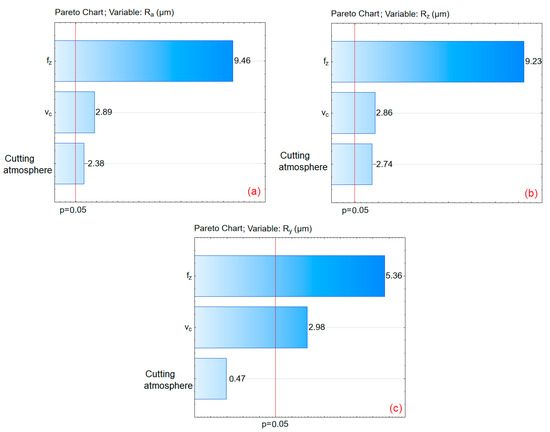
Figure 18.
Pareto chart for the surface roughness parameters (a) Ra, (b) Rz, and (c) Ry.
3.5. Tool Life and Wear Mechanisms
The average tool lives obtained with the various cutting atmospheres, considering the end-of-tool-life criterion stipulated for the corner flank wear (VBC) of 0.3 mm, are presented in Figure 19. Applying oil by the MQL method ensured longer tool lives, mainly with the mineral-based MQL14 oil. As expected, the lower cutting speed of 200 m/min achieved longer tool lives (compared to 250 m/min cutting speed). The cutting speed of 200 m/min was the maximum value recommended by the tool manufacturer for the feed rate of 0.14 mm/tooth.
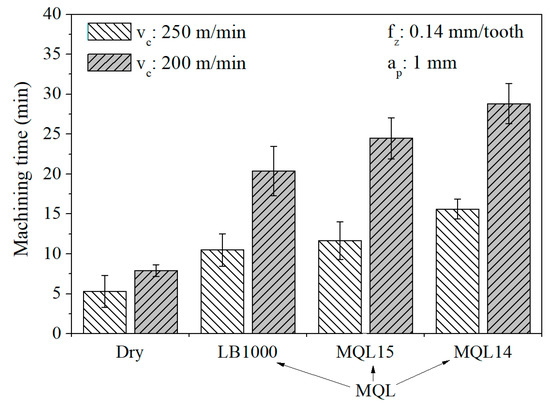
Figure 19.
The tool lives in AISI 1045 steel milling with MQL oils and dry machining.
Figure 19 also shows that in dry cutting, the tool lives were only slightly different for the two cutting speeds, but with the MQL oils, the difference in tool lives for cutting speeds of 200 and 250 m/min were found to be much higher. The results in this figure also show the classification of the oils applied by MQL based on the average tool lives. MQL14 was observed to be the best, followed by the MQL15 and LB1000 oils. However, when the dispersion bars are considered, the MQL14 does not appear better than MQL15 or LB1000. However, MQL14 was found to be better than LB1000. Again, the superior properties of the mineral oil MQL14 are credibly responsible for its best performance with both cutting speeds. This oil possibly carried exceptionally better wettability, viscosity, conductivity, and thermal diffusivity, and thus provides the best tribological results compared to its counterparts.
Figure 20, Figure 21, Figure 22 and Figure 23 illustrate the SEM images of the cutting tools (at the magnifications of 100 and 250×) at the end of their tool lives. Under all the cutting atmospheres and cutting speeds, the flank and crater wear were noticed in the main and secondary cutting edge region and at the corner.
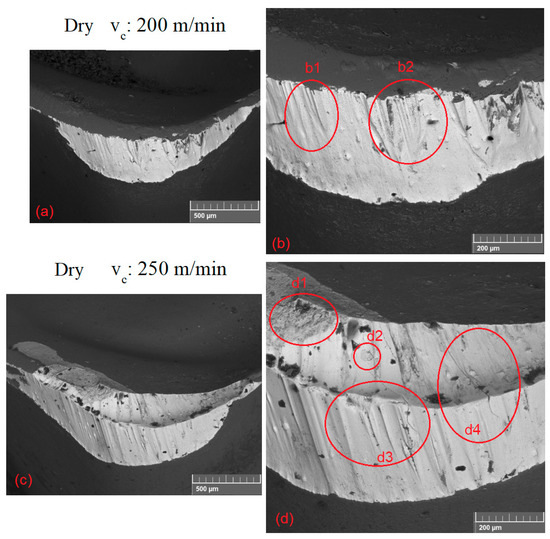
Figure 20.
Overview of the tool wear after milling AISI 1045 steel in the dry atmosphere with cutting speeds of (a,b) 200 m/min and (c,d) 250 m/min.
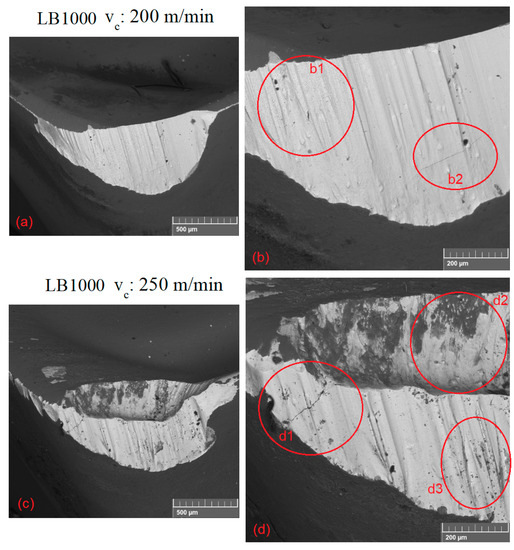
Figure 21.
Overview of the tool wear after milling AISI 1045 steel with the application of LB1000 oil with cutting speeds of (a,b) 200 m/min and (c,d) 250 m/min.
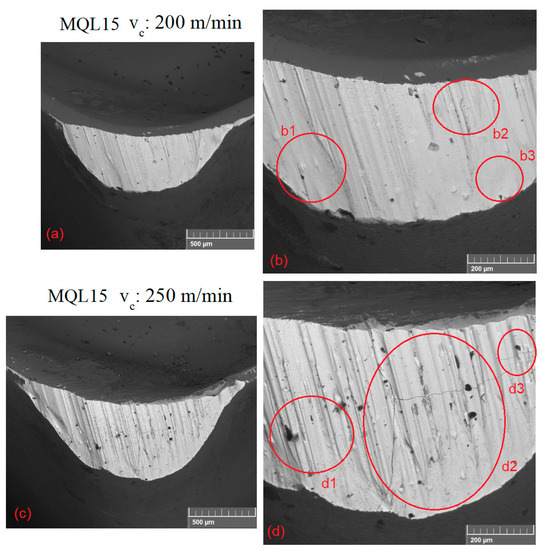
Figure 22.
Overview of the tool wear after milling AISI 1045 steel with the application of MQL15 oil with cutting speeds of (a,b) 200 m/min and (c,d) 250 m/min.

Figure 23.
Overview of the tool wear after milling AISI 1045 steel with the application of MQL14 oil with cutting speeds of (a,b) 200 m/min and (c,d) 250 m/min.
In Figure 20, the higher magnification (250×) image details depict the prevailing wear mechanisms in abrasion, adhesion, and diffusion. The parallel microgrooves further confirmed these observations on the flank and rake surfaces of the cutting tool (Figure 20, regions b1, b2, and d3), the rough surface being a result of the pulling out of carbide grains from the surface of the tool (in regions d1 and d2), and the smooth areas indicating the polishing effect provided by the loss of atoms from the surface of the cutting tool. At 250 m/min cutting speed, the thermal cracks (region d4) began to propagate, and the material started to adhere to the cutting tool. In the dry cutting, regardless of the cutting speed applied, the developed cracks (due to thermal fatigue, abrasion, adhesion, and diffusion) were possibly responsible for the wear and rapid deterioration of the tool’s cutting edge and the short service life.
Figure 21 demonstrates the SEM images of the cutting tools used in the tests with LB1000 oil applied by MQL at both cutting speeds. The images highlight the predominance of microchipping, abrasion wear mechanisms (Figure 21, regions b1, d1, and d3), and mechanical cracks (regions b2 and d1) on the tool’s flank surface. In the worn-out regions, the smooth (polished) areas can also be observed at both the cutting speeds, indicating the presence of the diffusive wear mechanism.
Figure 22 shows the SEM images of the cutting tools used in the tests with MQL15 oil at both cutting speeds. The mechanical and thermal cracks (Figure 22, regions d2 and d3) are present on the worn-out areas of the cutting tool used at the higher cutting speed (250 m/min). Parallel grooves are observed on the flank surfaces of the cutting tool used at both cutting speeds, indicating the predominance of abrasive wear (regions b2, d1, and d2). To a lesser extent than the dry condition, smooth (polished) regions are also observed in Figure 22, characterizing the presence of the diffusive wear mechanism (regions b1 and b3).
Finally, Figure 23 shows the SEM images of the cutting tool used in milling with MQL14 oil. Mechanical and thermal cracks (Figure 23, regions d2 and d4) were present in the tools used at 250 m/min cutting speed. The action of the adhesive wear mechanism could be observed in these tools (regions b2 and d3); however, the abrasive (regions b1 and d1) and diffusive wear mechanisms (in regions b3 and d5) predominated.
4. Conclusions
The results obtained after end milling of AISI 1045 steel under various cutting atmospheres allow the following conclusions to be drawn:
- Regardless of the measurement method, the milling temperatures exhibited lower values during the application of MQL fluids compared to dry cutting. This finding highlights that the application of MQL fluids can remarkably promote lubri-cooling of the chip–tool–workpiece interfaces, leading to a reduction of the generation of heat and friction considerably.
- MQL application of vegetable-based oils LB1000 and MQL15 showed equivalent machining forces and powers and were slightly higher than the dry cutting. This behavior was noticed due to the coolant effect of the MQL application and atomization of the cutting fluid. Consequently, the temperatures’ influence on the material’s mechanical strength was observed to be lower.
- Among the cutting parameters, feed per tooth had the most significant influence on the surface roughness for all the evaluated lubri-coolant conditions, as expected.
- The mineral-based MQL14 oil was noted to provide the best machining force and surface roughness results. These results could be justified by its high wettability, low viscosity, conductivity, thermal diffusivity, and best tribological results, characterizing it as the oil with the highest lubricity.
- End milling under the higher cutting speed of 250 m/min decreased the tool lives substantially, regardless of the cutting atmosphere condition used.
- The vegetable-based oil MQL15 showed similar tool life results to those presented by the mineral-based oil MQL14. Therefore, this vegetable oil might be preferred in similar industrial applications because of its higher sustainability.
- The tool wear mechanism analyses indicated that abrasion predominated, regardless of the cutting atmosphere and speed used. It was also confirmed by the several parallel microgrooves in the direction of the material flow (observed on the worn areas of the tools). Mechanical and thermal cracks were also noticed, and regions with rough and smooth aspects indicated the presence of adhesive and diffusive wear mechanisms on the cutting tools’ surfaces.
- The wear mechanisms did not change amid the application of an oil by MQL. However, under dry machining, the wear was accelerated.
Subsequent research on the concluding remarks of this work is highly encouraged, and similar investigations can be performed in other machining processes, such as drilling, reaming, threading, etc. Different vegetable-based oils should be considered and tested and when similar or better performance than mineral-based oils is proved, the same might be preferred in shop floors.
Author Contributions
Conceptualization, V.B., C.F.H. and Á.R.M.; methodology, V.B., L.R.R.d.S., F.L.A. and Á.R.M.; software, V.B., L.R.R.d.S. and R.D.; validation, M.J.J., F.L.A. and Á.R.M.; formal analysis, L.R.R.d.S., M.J.J., F.L.A. and Á.R.M.; investigation, V.B., and L.R.R.d.S.; resources, V.B., R.D., M.J.J., F.L.A. and Á.R.M.; data curation, L.R.R.d.S., C.F.H. and Á.R.M.; writing—original draft preparation, V.B., and L.R.R.d.S.; writing—review and editing, R.D., M.J.J., F.L.A., C.F.H. and Á.R.M.; visualization, V.B., L.R.R.d.S. and R.D.; supervision, Á.R.M.; project administration, C.F.H. and Á.R.M.; funding acquisition, F.L.A., C.F.H. and Á.R.M. All authors have read and agreed to the published version of the manuscript.
Funding
This study was financed in part by the Coordenação de Aperfeiçoamento de Pessoal de Nível Superior–Brasil (CAPES)–Finance Code 001 and CNPq.
Data Availability Statement
Not applicable.
Acknowledgments
The authors would like to thank SpecialMix Industrial Ltda for supplying two of the oils tested. They also thank the Pontifical Catholic University of Paraná (PUCPR) and the Federal University of Uberlândia, Brazil, for providing the lab facilities. We are also grateful to CAPES and CNPq for their financial support.
Conflicts of Interest
The authors declare no conflict of interest.
References
- Da Silva, R.B.; Vieira, J.M.; Cardoso, R.N.; Carvalho, H.C.; Costa, E.S.; Machado, A.R.; De Ávila, R.F. Tool Wear Analysis in Milling of Medium Carbon Steel with Coated Cemented Carbide Inserts Using Different Machining Lubrication/Cooling Systems. Wear 2011, 271, 2459–2465. [Google Scholar] [CrossRef]
- da Silva, L.R.R.; Souza, F.C.R.; Guesser, W.L.; Jackson, M.J.; Machado, A.R. Critical Assessment of Compacted Graphite Cast Iron Machinability in the Milling Process. J. Manuf. Process. 2020, 56, 63–74. [Google Scholar] [CrossRef]
- Goindi, G.S.; Sarkar, P. Dry Machining: A Step towards Sustainable Machining – Challenges and Future Directions. J. Clean. Prod. 2017, 165, 1557–1571. [Google Scholar] [CrossRef]
- Da Silva, L.R.R.R.; Del Claro, V.T.S.S.; Andrade, C.L.F.F.; Guesser, W.L.; Jackson, M.J.; Machado, A.R. Tool Wear Monitoring in Drilling of High-Strength Compacted Graphite Cast Irons. Proc. Inst. Mech. Eng. B J. Eng. Manuf. 2021, 235, 207–218. [Google Scholar] [CrossRef]
- Pimenov, D.Y.; Mia, M.; Gupta, M.K.; Machado, Á.R.; Pintaude, G.; Unune, D.R.; Khanna, N.; Khan, A.M.; Tomaz, Í.; Wojciechowski, S.; et al. Resource Saving by Optimization and Machining Environments for Sustainable Manufacturing: A Review and Future Prospects. Renew. Sustain. Energy Rev. 2022, 166, 112660. [Google Scholar] [CrossRef]
- Saleem, M.Q.; Mehmood, A. Eco-Friendly Precision Turning of Superalloy Inconel 718 Using MQL Based Vegetable Oils: Tool Wear and Surface Integrity Evaluation. J. Manuf. Process. 2022, 73, 112–127. [Google Scholar] [CrossRef]
- da Silva, L.R.R.; Favero Filho, A.; Costa, E.S.; Pico, D.F.M.; Sales, W.F.; Guesser, W.L.; Machado, A.R.; Filho, A.F.; Costa, E.S.; Marcucci Pico, D.F.; et al. Cutting Temperatures in End Milling of Compacted Graphite Irons; Elsevier: Amsterdam, The Netherlands, 2018; Volume 26, pp. 474–484. [Google Scholar] [CrossRef]
- Baldin, V.; da Silva, L.R.R.; Machado, A.R.; Houck, C.F. State of the Art of Biodegradable Nanofluids Application in Machining Processes. Int. J. Precis. Eng. Manuf.-Green. Technol. 2022, 1–38. [Google Scholar] [CrossRef]
- Cyprowski, M.; Piotrowska, M.; Zakowska, Z.; Szadkowska-Stańczyk, I. Microbial and Endotoxin Contamination of Water-Soluble Metalworking Fluids. Int. J. Occup. Med. Environ. Environ. Health 2007, 20, 365–371. [Google Scholar] [CrossRef]
- Mannekote, J.K.; Kailas, S.V.; Venkatesh, K.; Kathyayini, N. Environmentally Friendly Functional Fluids from Renewable and Sustainable Sources-A Review. Renew. Sustain. Energy Rev. 2018, 81, 1787–1801. [Google Scholar] [CrossRef]
- Sen, B.; Mia, M.; Krolczyk, G.M.; Mandal, U.K.; Mondal, S.P. Eco-Friendly Cutting Fluids in Minimum Quantity Lubrication Assisted Machining: A Review on the Perception of Sustainable Manufacturing. Int. J. Precis. Eng. Manuf.-Green Technol. 2019, 8, 249–280. [Google Scholar] [CrossRef]
- Dhar, N.R.; Ahmed, M.T.; Islam, S. An Experimental Investigation on Effect of Minimum Quantity Lubrication in Machining AISI 1040 Steel. Int. J. Mach. Tools Manuf. 2007, 47, 748–753. [Google Scholar] [CrossRef]
- Machado, Á.R.; Wallbank, J. The Effect of Extremely Low Lubricant Volumes in Machining. Wear 1997, 210, 76–82. [Google Scholar] [CrossRef]
- da Silva, L.R.R.; Ruzzi, R.S.; Teles, V.C.; Sales, W.F.; Guesser, W.L.; Machado, A.R. Analysis of the Coefficient of Friction at the Workpiece-Tool Interface in Milling of High Strength Compacted Graphite Cast Irons. Wear 2019, 426–427, 1646–1657. [Google Scholar] [CrossRef]
- Ezugwu, E.O.; da Silva, R.B.; Bonney, J.; Costa, E.S.; Sales, W.F.; Machado, A.R. Evaluation of Performance of Various Coolant Grades When Turning Ti-6Al-4V Alloy with Uncoated Carbide Tools under High-Pressure Coolant Supplies. J. Manuf. Sci. Eng. 2019, 141, 014503. [Google Scholar] [CrossRef]
- Hoon, S.; Won, S.; Han, S.; Kim, S. Numerical Investigation of Thermal Characteristics of Spray Cooling with Minimum Quantity Lubrication in Milling Process. Appl. Math. Model. 2019, 65, 137–147. [Google Scholar] [CrossRef]
- Patole, P.B.; Kulkarni, V.V.; Bhatwadekar, S.G. MQL Machining with Nano Fluid: A Review. Manuf. Rev. 2021, 8, 13. [Google Scholar] [CrossRef]
- ASTM E8/E8M; Standard Test Methods for Tension Testing of Metallic Materials. Astm International: West Conshohocken, PA, USA, 2013.
- Baldin, V.; da Silva, L.R.R.; Gelamo, R.V.; Iglesias, A.B.; da Silva, R.B.; Khanna, N.; Rocha Machado, A. Influence of Graphene Nanosheets on Thermo-Physical and Tribological Properties of Sustainable Cutting Fluids for MQL Application in Machining Processes. Lubricants 2022, 10, 193. [Google Scholar] [CrossRef]
- ABNT NBR NM 87; Aço Carbono e Ligados Para Construção Mecânica—Designação e Composição Química. Associação Brasileira de Normas Técnicas: São Paulo, Brazil, 2000.
- ABNT NBR 14725; Produtos Químicos—Informações Sobre Segurança, Saúde e Meio Ambiente: Ficha de Informações de Segurança de Produtos Químicos (FISPQ). Associação Brasileira de Normas Técnicas: São Paulo, Brazil, 2019.
- Baldin, V.; da Silva, L.R.R.; Houck, C.F.; Gelamo, R.V.; Machado, Á.R. Effect of Graphene Addition in Cutting Fluids Applied by Mql in End Milling of Aisi 1045 Steel. Lubricants 2021, 9, 70. [Google Scholar] [CrossRef]
- Richetti, A.; Machado, Á.R.; Da Silva, M.B.; Ezugwu, E.O.; Bonney, J. Influence of the Number of Inserts for Tool Life Evaluation in Face Milling of Steels. Int. J. Mach. Tools Manuf. 2004, 44, 695–700. [Google Scholar] [CrossRef]
- Davoodi, B.; Hosseinzadeh, H. A New Method for Heat Measurement during High Speed Machining. Measurement 2012, 45, 2135–2140. [Google Scholar] [CrossRef]
- Soler, D.; Aristimuño, P.X.; Saez-de-Buruaga, M.; Garay, A.; Arrazola, P.J. New Calibration Method to Measure Rake Face Temperature of the Tool during Dry Orthogonal Cutting Using Thermography. Appl. Therm. Eng. 2018, 137, 74–82. [Google Scholar] [CrossRef]
- Umbrello, D.; Filice, L.; Rizzuti, S.; Micari, F. On the Evaluation of the Global Heat Transfer Coefficient in Cutting. Int. J. Mach. Tools Manuf. 2007, 47, 1738–1743. [Google Scholar] [CrossRef]
- Machado, A.R.; Abrão, A.M.; Coelho, R.T.; Silva, M.B. Da Teoria da Usinagem dos Materiais, 3rd ed.; Editora Edgard Blucher: São Paulo, Brazil, 2015; ISBN 978-85-212-0452-7. [Google Scholar]
- Carvalho, D.O.A.; da Silva, L.R.R.; Sopchenski, L.; Jackson, M.J.; Machado, Á.R. Performance Evaluation of Vegetable-Based Cutting Fluids in Turning of AISI 1050 Steel. Int. J. Adv. Manuf. Technol. 2019, 103, 1603–1619. [Google Scholar] [CrossRef]
- Bashir, M.A.; Mia, M.; Dhar, N.R. Investigations on Surface Milling of Hardened AISI 4140 Steel with Pulse Jet MQL Applicator. J. Inst. Eng. Ser. C 2018, 99, 301–314. [Google Scholar] [CrossRef]
Disclaimer/Publisher’s Note: The statements, opinions and data contained in all publications are solely those of the individual author(s) and contributor(s) and not of MDPI and/or the editor(s). MDPI and/or the editor(s) disclaim responsibility for any injury to people or property resulting from any ideas, methods, instructions or products referred to in the content. |
© 2023 by the authors. Licensee MDPI, Basel, Switzerland. This article is an open access article distributed under the terms and conditions of the Creative Commons Attribution (CC BY) license (https://creativecommons.org/licenses/by/4.0/).